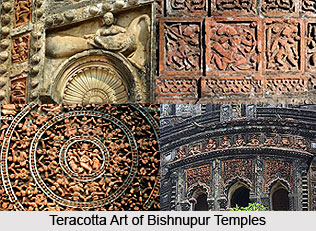 History of Bankura district goes back a long way. It used to form a part of the Rarh district in ancient times. Initially, this area was occupied by the aboriginal tribes. It was Aryanised with the people and culture of the Proto-Indo-European group, who prevailed in northern India, substantially later than rest of Bengal. The two main groups of people at this point in time were the Nishadas (who were Proto-Australoid tribes) and Dasa-dasyus (related to Dravidians). The process of assimilation with Proto-Indo-Europeans took a long time in the making, centuries in fact, and was achieved through both conflict as well as cordiality.
History of Bankura district goes back a long way. It used to form a part of the Rarh district in ancient times. Initially, this area was occupied by the aboriginal tribes. It was Aryanised with the people and culture of the Proto-Indo-European group, who prevailed in northern India, substantially later than rest of Bengal. The two main groups of people at this point in time were the Nishadas (who were Proto-Australoid tribes) and Dasa-dasyus (related to Dravidians). The process of assimilation with Proto-Indo-Europeans took a long time in the making, centuries in fact, and was achieved through both conflict as well as cordiality.
The history of the district of Bankura from the 7th century AD right until the advent of British rule is dominated by the Hindu Rajas of Bishnupur. The origin of the Rajas of Bishnupur is quite unclear. Though they were acknowledged as the King of Bagdis, it has been claimed by their followers and even the Kings themselves that they were descended from the Kshatriya clans of Northern India. The Rajas of Bishnupur were also known as Malla kings. As a result, the area around Bishnupur was called Mallabhum. This area would approximately cover present day Bankura police station area (excluding Chhatna), Onda, Bishnupur, Kotulpur and Indas. In the north it stretched from Damin-i-koh in Santhal Parganas to Midnapore in the south. It included the eastern part of Bardhaman and parts of Chota Nagpur in the west.
The Malla dynasty was founded by Adi Malla. Also known as Bagdi Raja, his reign went on for 33 years. He was succeeded by his son, Jay Malla, who invaded Padampur and captured the fort, then the power-centre. Having increased the size of his kingdom, Jay Malla shifted the capital to Bishnupur. The various Malla Kings who followed Jay Malla steadily added to the dominions and further expanded the reach of the kingdom. Well known among the various Malla rulers were Kalu Malla, the fourth in line, Kau Malla, the sixth in line, Jhau Malla, the seventh in line, and Sur Malla, the eighth in line, who defeated the Raja of Bagri, a place now in northern Midnapore.
Having reached the pinnacle of success in the latter half of the 17th century, the reign of the Bishnupur Rajas started declining towards the first half of the 18th century. First, the Maharaja of Burdwan seized the Fatehpur Mahal. Following this, repeated Maratha invasions ruined the kingdom. Seobhat, the Maratha chief, made Bishnupur his headquarters in 1760. The Marathas attacked the border principalities of Bishnupur and Birbhum with great vigour, and subsequently, added to by varied taxations and exactions, the kingdom was reduced to poverty. People started to flee from the place and the place was struck with desolation. Intrigue, conspiracy and litigation ruined the Royal family, and ultimately the estate was sold for arrears of land revenue to the Maharaja of Burdwan.
In 1760, when Burdwan Chakla was ceded to the British, Bishnupur went along with it. The land was in complete ruins now. Lawlessness, destruction, poverty and to top it all the Bengal famine of 1769-1770 had rendered the land completely unmanageable. This led to the emergence of Chuars or robbers who started looting the people for food and money. In 1787, Bishnupur was united with Birbhum to form a separate administrative unit; the headquarters was shifted to Suri. It continued to be part of the Birbhum District till 1793 when it was transferred to the Burdwan Collectorate. Towards the end of the 18th century certain portions of the district around Raipur was affected by the Chuar rebellion. The police force was simply not in a position to control the situation.
The district of Bankura as it exists today acquired its shape in 1879. The thanas of Khatra and Raipur and the outpost of Simplapal were transferred here from Manbhum and the thanas of Sonamukhi, Kotulpur and Indas were re-transferred here from Burdwan. It was known as West Burdwan till 1881, when it finally came to be called Bankura district.






